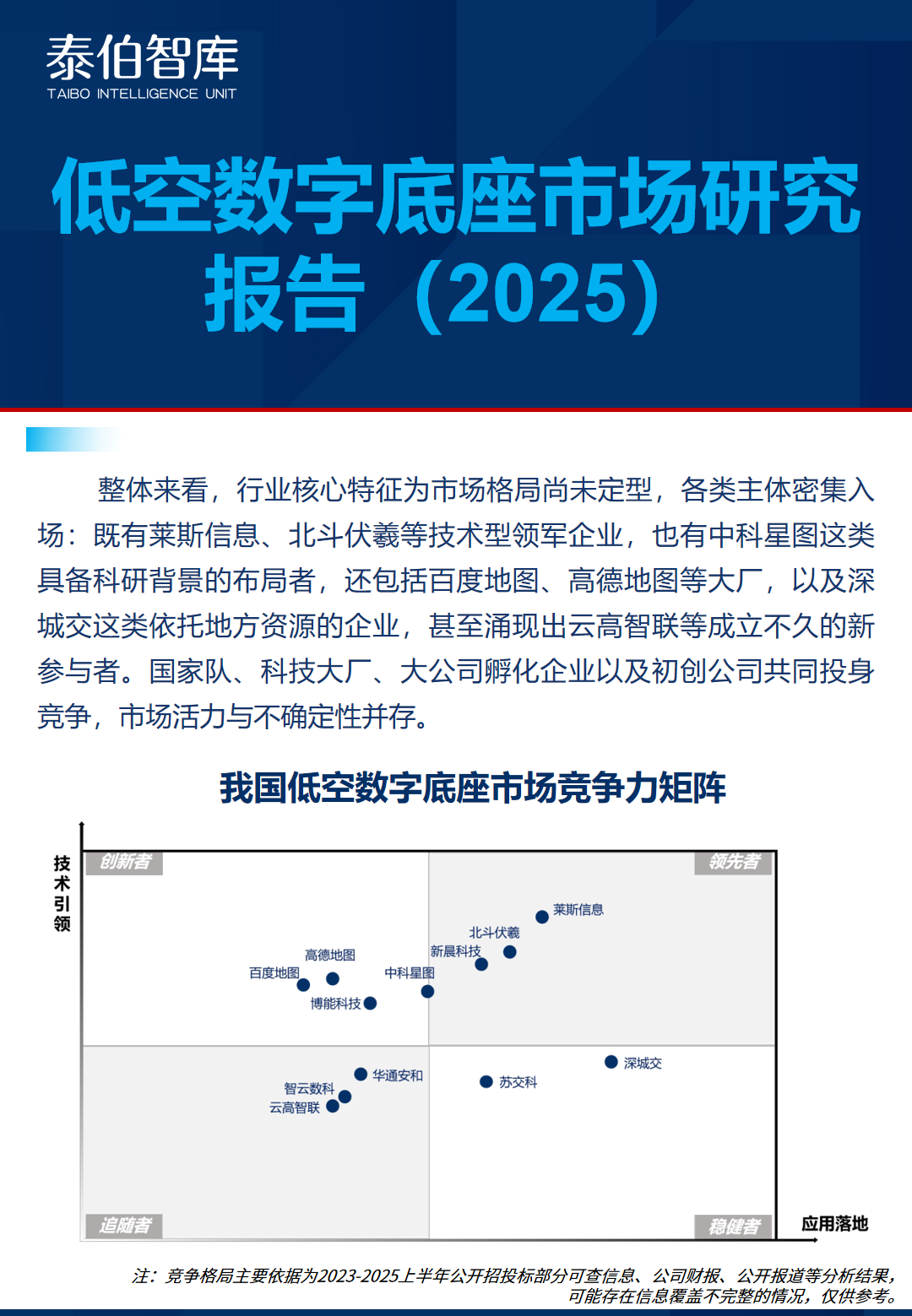Recently, Taibo Think Tank released the 2025 Low altitude Digital Base Market Competitiveness Matrix, which provides an in-depth analysis and evaluation of the main participants in the low altitude digital base market from two dimensions: technological leadership and application implementation, showcasing the current competitive landscape of the industry.
Overall, the core feature of the low altitude digital base industry is that the market pattern has not yet been finalized, and various entities have entered intensively. The national team, technology giants, incubated enterprises of large companies, and startups jointly engage in competition, and the market vitality and uncertainty coexist.

From the player composition of the four quadrants of the matrix, the Leading quadrant is mainly composed of companies such as Laisi Information, BeiDou Fuxi, and Xinchen Technology. On the one hand, they continue to invest in key technological fields such as low altitude perception and data processing, building irreplaceable technological advantages; On the other hand, from the bidding data, it has undertaken a large number of projects with high quality and wide coverage, making it a benchmark force for project implementation in the industry, with comprehensive strength far ahead.
The Innovator quadrant focuses on technological reserves as its core advantage, and its application implementation is still in the expansion stage. Representative enterprises include Zhongke Xingtu, Baidu Maps, Gaode Maps, and Boneng Technology. In recent years, Zhongke Xingtu has listed low altitude business as a key layout direction, gradually transforming its technological reserves into project landing capabilities, and is expected to evolve from the innovator camp to the leader camp; Baidu Maps and Gaode Maps adopt a differentiation strategy: they do not participate in early-stage project competition in the market, but wait for the market to become relatively mature and start from the platform construction and industry standard setting level, relying on their own geographic information ecosystem accumulation to seize the later industry discourse power.
Stable playersThe quadrant relies on policies and existing businesses to achieve "preconceived notions", with core players includingShencheng Transportation,Sujiaokeand other enterprises.. Taking Shenzhen Chengjiao as an example, its advantages mainly stem from two aspects: firstly, obtaining early local policy support and deeply participating in the top-level planning work of low altitude economy pilot cities such as Shenzhen and Guangzhou; Secondly, with its long-term layout in the field of smart city transportation, it can seamlessly integrate existing businesses with the demand for low altitude digital bases, thereby occupying a first mover advantage in the regional market.
The Followers quadrant is a new force that has emerged in recent years, breaking through and opening up the market through segmented fields, including Huatong Anhe, Zhiyun Shuke, and Yungao Zhilian. Although these types of enterprises do not have a nationwide comprehensive advantage, they perform outstandingly in segmented tracks: Huatong Anhe focuses on hardware equipment supply and has won tens of millions of large orders; Zhiyun Numerical Technology leverages the resources of China Software International to precisely enter the field of low altitude computing power; As a company established last year, Yungao Zhilian quickly responded to local demand and successfully won the bid for a large-scale project in Longgang, demonstrating strong market entry capabilities.
From the perspective of market dynamics, the current competitive focus is concentrated on three dimensions: firstly, technological positioning capability. The vertical axis of technological investment and barriers directly determine the upper limit of enterprises. Only by continuously breaking through in key technological fields can homogeneous competition be avoided; The second is the efficiency and quality of application implementation. The bidding data on the horizontal axis is the core indicator of market recognition, especially the ability to undertake and deliver medium-sized projects, which will affect the company's reputation and subsequent order acquisition; The third is the ability to integrate local resources and policies. The low altitude digital base is deeply bound to regional planning, and whether it can rely on existing business to meet local needs has become a key factor for enterprises to quickly open up regional markets.
- The content and related data in this article are all from the recently released"Low altitude Digital Base Market Research Report (2025)"(Click on the text to jump).








